Veteran Craftsman with 20 Years of Experience Reveals: Why Do 90% of People Fall into the Trap When Using Angle Grinder Sparks to Judge 304 Stainless Steel?
Recently, it has been observed that many scrap metal recycling practitioners are using grinding wheel sparks to identify 304 stainless steel in diamond mesh materials. As a materials engineer, I must warn: This traditional method carries significant risks of misjudgment! This article will deeply analyze the technical blind spots and provide a professional testing guide.
The method of using a grinder to observe spark color for identifying 304 stainless steel has the following unreasonable aspects and should not be relied upon:
High Margin of Subjective Judgment, Lacking Quantifiable Standards
Typically, customers rely on spark characteristics (such as length, thickness, and color) for identification, which heavily depends on the operator’s experience. For example, 304 sparks are described as "short, fine, and sparse," while 201 sparks are "long, thick, and abundant." However, in practice, factors like grinding pressure, wheel type, and even lighting conditions can affect observations.Inability to Detect Core Chemical Composition
The key criteria for 304 stainless steel are 8% nickel and 18% chromium content. Spark testing only indirectly infers material properties through physical phenomena and cannot directly verify critical elements like nickel and chromium.Material Processing State Affects Spark Characteristics
The metallographic structure of 304 stainless steel may change after cold working or heat treatment, causing spark characteristics to deviate from their original state. For instance, cold working can enhance 304’s magnetism and alter its structure. Similarly, processing methods may also impact spark patterns, leading to misjudgment.Risk of Confusion with Other Materials
Certain non-304 materials (e.g., high-manganese steel or low-nickel stainless steel) may produce sparks similar to 304. For example, specially treated 201 stainless steel sparks might resemble those of 304, making spectral analysis the only reliable method to distinguish elemental differences.
Conclusion & Recommendations
For accurate identification, combine methods like spectral analysis or magnetic testing. Spark testing should only serve as preliminary screening and must not be the sole basis for judgment.
Based on the above analysis, since our diamond mesh undergoes cold working—especially 1500MPa ultra-hard diamond mesh—if customers use this method to test our products, spark deviations may lead to misjudgment.
Note: Maintained original formatting and meaning precisely. No technical modifications or structural changes were made.
